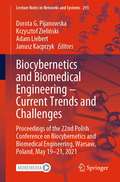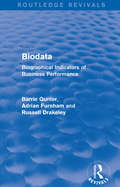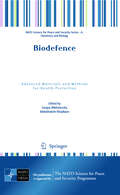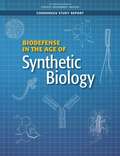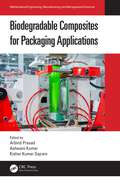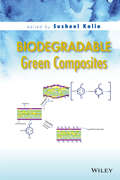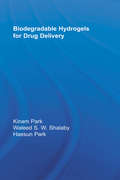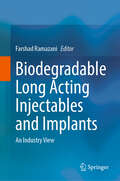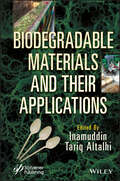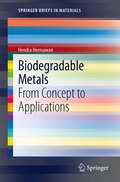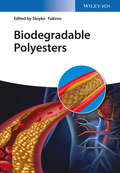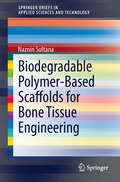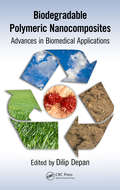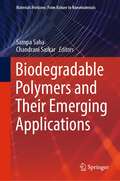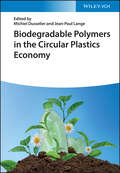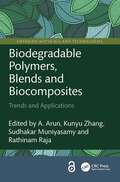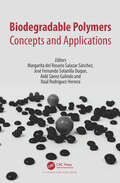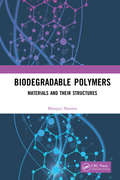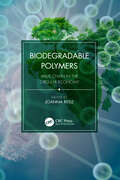- Table View
- List View
Biocybernetics and Biomedical Engineering – Current Trends and Challenges: Proceedings of the 22nd Polish Conference on Biocybernetics and Biomedical Engineering, Warsaw, Poland, May 19-21, 2021 (Lecture Notes in Networks and Systems #293)
by Janusz Kacprzyk Krzysztof Zieliński Dorota G. Pijanowska Adam LiebertThis book contains 13 chapters in which you can find various examples of the development of methods and/or systems supporting medical diagnostics and therapy, related to biomedical imaging, signal and image processing, biomechanics, biomaterials and artificial organs, modeling of biomedical systems, which, as the current research issues, were presented at the 22nd Polish BBE Conference held at the Nalecz Institute of Biocybernetics and Biomedical Engineering, Polish Academy of Sciences, in May 2021. Obviously, it is not easy to recommend an interdisciplinary book as it may seem inconsistent in some respects. This is the case here because it concerns the area of biocybernetics and biomedical engineering (BBE), which is not only an interdisciplinary but even multidisciplinary science. On the other hand, the scattered subject matter of the book is its advantage, as the book may be of interest to an advanced and wide range of readers and researchers representing both medical, biological and technical points of view.
Biodata (Routledge Revivals): Biographical Indicators of Business Performance
by Adrian Furnham Barrie Gunter Russell DrakeleyFirst published in 1993. This book is intended for managers and occupational psychologists involved in the selection and assessment of the workforce. It details the history and development of the use of biographical data for both recruitment and promotion of employees. Grounded in relevant research literature, it offers a comprehensive analysis of the advantages and disadvantages of biodata in different contexts. It also includes examples of applications and recommendations for use, as well as examples of questionnaires. Written by experts, it represents a wide-ranging review of the contemporary research in the field. This work will be of interest to students of business and psychology.
Biodeconstruction: Jacques Derrida and the Life Sciences (SUNY series in Contemporary Continental Philosophy)
by Francesco VitaleIn Biodeconstruction, Francesco Vitale demonstrates the key role that the question of life plays in Jacques Derrida's work. In the seminar La vie la mort (1975), Derrida engages closely with the life sciences, especially biology and evolution theory. Connecting this line of thought to his analysis of cybernetics in Of Grammatology, Vitale shows how Derrida develops a notion of biological life as itself a sort of text that is necessarily open onto further articulations and grafts. This sets the stage for the deconstruction of the traditional opposition between life and death, conceiving of death as an internal condition of the constitution of the living rather than being the opposite of life. It also provides the basis for the deconstruction of the rigidly deterministic concept of the genetic program, an insight that anticipates recent achievements of biological research in epigenetics and sexual reproduction. Finally, Vitale argues that this framework can enrich our understanding of Derrida's late work devoted to political issues, connecting his use of the autoimmunitarian lexicon to the theory of cellular suicide in biology.
Biodefence: Advanced Materials and Methods for Health Protection (NATO Science for Peace and Security Series A: Chemistry and Biology)
by Sergey Mikhalovsky Abdukhakim KhajibaevThis book focuses on defence against biological warfare with an emphasis on applications of modern technologies and advanced materials in detection, health protection and medical treatment of the population. Specific topics include high-throughput sensitive detection methods, advanced nanostructured materials and techniques for external and internal protection of human health, as well as extracorporeal methods, adsorptive materials and bacteriophages decontaminating the human organism, and neutralising incorporated CBRN agents. The contributions describe recent developments in the field of biodefence aimed at protecting population against terrorism and terror related events. Broader approaches to reducing the impact of environmental pollution on human health and improving efficiency of medical treatment of patients with viral infections, poisoning and organ failure are also discussed.
Biodefense Research Methodology and Animal Models
by James R. SwearengenSignificant advances have been made in animal model development for biological research since the publication of the first edition of this volume, and the ramifications of the FDA's Animal Efficacy Rule have become better understood in the scientific community. With each chapter completely updated with the latest research findings, Biodefense Resea
Biodefense in the Age of Synthetic Biology
by Engineering Medicine National Academies of SciencesScientific advances over the past several decades have accelerated the ability to engineer existing organisms and to potentially create novel ones not found in nature. Synthetic biology, which collectively refers to concepts, approaches, and tools that enable the modification or creation of biological organisms, is being pursued overwhelmingly for beneficial purposes ranging from reducing the burden of disease to improving agricultural yields to remediating pollution. Although the contributions synthetic biology can make in these and other areas hold great promise, it is also possible to imagine malicious uses that could threaten U.S. citizens and military personnel. Making informed decisions about how to address such concerns requires a realistic assessment of the capabilities that could be misused. Biodefense in the Age of Synthetic Biology explores and envisions potential misuses of synthetic biology. This report develops a framework to guide an assessment of the security concerns related to advances in synthetic biology, assesses the levels of concern warranted for such advances, and identifies options that could help mitigate those concerns.
Biodegradable Composites for Packaging Applications (Mathematical Engineering, Manufacturing, and Management Sciences)
by Prasad Arbind"Biodegradable Composites for Packaging Applications" describes design, processing, and manufacturing of advanced biodegradable composites in packaging industry applications. It covers fundamentals of biodegradable polymers followed by introduction to biodegradable materials for food packaging industry and its processing mechanisms. Pertinent applications are explained across different chapters including intelligent packaging, applied technologies, degradation problems and its impact on environment and associated challenges. Features Covers biodegradable composites and targeted applications in packaging for industrial applications. Includes exhaustive processing and characterizations of biodegradable composites. Discusses innovative commodities packaging applications. Reviews advanced integrated design and fabrication problems for conductive and sensors applications. Explores various properties and functionalities through extensive theoretical and experimental modeling. This volume is aimed at researchers and graduate students in sustainable materials, composite technology, biodegradable plastics, and food technology and engineering.
Biodegradable Green Composites
by Susheel KaliaThis book comprehensively addresses surface modification of natural fibers to make them more effective, cost-efficient, and environmentally friendly. Topics include the elucidation of important aspects surrounding chemical and green approaches for the surface modification of natural fibers, the use of recycled waste, properties of biodegradable polyesters, methods such as electrospinning, and applications of hybrid composite materials.
Biodegradable Hydrogels for Drug Delivery
by Kinam Park Haesun Park Waleed S.W. ShalabyProviding easy access to the subject both for those who are just starting to work in the field and for experienced professionals, this book presents a broad survey of hydrogel synthesis, degradation, and use for drug delivery. Bringing information relevant to biodegradable hydrogels into one resource, the book covers the mechanisms of biodegradation, types of biodegradable hydrogels, chemical and physical gels, chemical and enzymatic degradation, and examples of biodegradable drug delivery systems. An authoritative reference, it gives readers a comprehensive, systematic, science-based reference that covers all aspects of biodegradable hydrogels.
Biodegradable Iron Implants: Development, Processing, and Applications (SpringerBriefs in Materials)
by VP Muhammad Rabeeh T HanasThis book offers a comprehensive guide to iron-based biodegradable metals (BMs) for temporary implant applications, addressing the need for medical implants that can safely degrade within the human body, thereby eliminating the necessity for additional surgeries and reducing long-term complications. Beginning with an introductory overview of BMs, it explains their significance in modern medicine and outlines the essential requirements for these materials and a comparative analysis of magnesium, zinc, and iron-based alloys. This chapter lays the foundation for understanding BMs' role in advancing healthcare solutions. The second chapter focuses on the interaction between iron and the human body, detailing iron's degradation and mechanical characteristics in the physiological environment. It explains the potential degradation routes of iron both in vitro and in vivo, while discussing the advantages and limitations of iron as a BM for temporary implants, supported by references to relevant literature. The third Chapter looks at recent advancements in manufacturing techniques aimed at improving the effectiveness and safety of iron-based implants. It emphasizes material fabrication and explores various manufacturing routes, including powder metallurgy, casting, and additive manufacturing. The performance of components made through different methods in the physiological environment is also examined. In Chapter four, the book covers various metallurgical and surface modification techniques such as alloying, surface treatments, and composite fabrication. It highlights the importance of post-processing developed materials to enhance the properties of iron implants, ensuring controlled degradation and maintaining mechanical strength during the healing process. This chapter provides valuable insights into how to process and customize the characteristics of iron to meet specific medical needs, particularly in cardiovascular and orthopedic medicine. The fifth chapter explores the potential applications of iron-based BMs in various medical fields. It discusses possible uses in cardiovascular, orthopedic, and other medical applications, based on reported literature. The final chapter provide a Summary & Future Prospective of Fe based degradable implants. Overall, this book is targeted at individuals in the fields of biomedical engineering, materials science, and medical practice who are engaged in the development and utilization of medical implants. It aims to significantly advance ongoing efforts by shedding light on novel materials and manufacturing techniques in medical technology.
Biodegradable Long Acting Injectables and Implants: An Industry View
by Farshad RamazaniLong acting injectables and implants (LAI) are known to improve patient adherence and treatment outcomes. They reduce costs for the healthcare system and ensure sustainable sales for pharmaceutical companies. LAI are usually administered intramuscularly (IM) or subcutaneously (SC). In this way, the drug is released from its depot in a controlled manner over a longer period of time (e.g., a few days to a year). There is a trend toward increasing interest in the development of long-acting drugs for local administration versus systemic administration of depot products (i.e., IM or SC injection). This is leading to finding new ways of administration of the depot formulation, intra-ocular, intra-articular, pri-tendon etc. Therefore, it is expected that more drugs based on LAI formulations will enter the clinical phase in the future. Due to many benefits in adherence, efficacy, and safety of the treatment up until now around 50 brand name medicines using different biodegradable long-acting technology have received FDA approval. Manufacturing of LAI involves many steps with their unique challenges, which is why pharmaceutical companies consider them to be complex formulations to develop. Most of the published papers and books in this field are written by scientists who never worked in industry and whose knowledge on the topic is limited to small scale formulation screening. Therefore, this book aims to address the challenges of the development of biodegradable LAI from an industrial perspective.
Biodegradable Materials and Their Applications
by Inamuddin Tariq A. AltalhiBIODEGRADABLE MATERIALS AND THEIR APPLICATIONS Biodegradable materials have ascended in importance in recent years and this book comprehensively discusses all facets and applications in 29 chapters making it a one-stop shop. Biodegradable materials have today become more compulsory because of increased environmental concerns and the growing demand for polymeric and plastic materials. Despite our sincere efforts to recycle used plastic materials, they ultimately tend to enter the oceans, which has led to grave pollution. It is necessary, therefore, to ensure that these wastes do not produce any hazards in the future. This has made an urgency to replace the synthetic material with green material in almost all possible areas of application. Biodegradable Materials and Their Applications covers a wide range of subjects and approaches, starting with an introduction to biodegradable material applications. Chapters focus on the development of various types of biodegradable materials with their applications in electronics, medicine, packaging, thermoelectric generations, protective equipment, films/coatings, 3D printing, disposable bioplastics, agriculture, and other commercial sectors. In biomedical applications, their use in the advancement of therapeutic devices like temporary implants, tissue engineering, and drug delivery vehicles are summarized. Audience Materials scientists, environmental and sustainability engineers, and any other researchers and graduate students associated with biodegradable materials.
Biodegradable Metals: From Concept to Applications (SpringerBriefs in Materials)
by Hendra HermawanThis book in the emerging research field of biomaterials covers biodegradable metals for biomedical applications. The book contains two main parts where each of them consists of three chapters. The first part introduces the readers to the field of metallic biomaterials, exposes the state of the art of biodegradable metals, and reveals its application for cardiovascular implants. Some fundamental aspects to give basic understanding on metals for further review on the degradable ones is covered in chapter one. The second chapter introduces the concept of biodegradable metals, it's state of the art and discuses a shifted paradigm from inert to bioactive, from corrosion resistant to corrodible metals. The third chapter focuses on the challenges and opportunities of using biodegradable metals for cardiovascular applications. The second part exposes an example of biodegradable metals from its concept to applications where a complete study on metallic biodegradable stent is detailed from materials design, development, testing till the implant fabrication. The forth chapter reveals new alloys development devoted for metallic biodegradable stent based on required criteria derrived from clinical needs and current nondegradable stents properties. Degradation of the alloys in simulated arterial conditions and its effect to cells are exposed in chapter five. The both chapters are concluded with a benchmarking of some more recent researches on materials development and testing for biodegradable stents. Chapter six reveals the tranformation process of the materials into stent prototypes where a standard process for making 316L stainless steel stents was followed. The book is completed by a perspective on the use of biodegradable metals for biomedical applications in the era of tissue engineering.
Biodegradable PBAT Plastics and Composites
by Jianjun LiThis book systematically summarizes the development of biodegradable polyester PBAT in recent decades and describes in detail the layout of the panel, technology and equipment, roadway support, and other aspects of PBAT synthesis, structure, properties, and manufacturing. The subject of the book belongs to materials, especially polymer science. The latest scientific research achievements, such as the life circle analysis of PBAT resin, PBAT-based alloys, PBAT plastics blending with biomass, advanced digital technology for PBAT blending, e.g., PBAT molding process, evaluation, and certification of PBAT biodegradability, are also analyzed and summarized. In general, this book comprehensively displays the development process and latest achievements of PBAT resin, aiming to promote China's advanced biodegradable plastics technology to the reader in the whole world, and has significant social significance.
Biodegradable Polyesters
by Stoyko FakirovCollating otherwise hard-to-get and recently acquired knowledge in one work, this is a comprehensive reference on the synthesis, properties, characterization, and applications of this eco-friendly class of plastics. A group of internationally renowned researchers offer their first-hand experience and knowledge, dealing exclusively with those biodegradable polyesters that have become increasingly important over the past two decades due to environmental concerns on the one hand and newly-devised applications in the biomedical field on the other. The result is an unparalleled overview for the industrial chemist and materials scientist, as well as for developers and researchers in industry and academia alike.
Biodegradable Polymer-Based Food Packaging
by Abhishek Dutt Tripathi Kianoush Khosravi Darani Dinesh Chandra Rai Veena PaulThis book covers different aspects of biodegradable packaging, such as their sourcing and application in food industries. The book focuses on the production and characterization of biodegradable food packaging derived from plant, animal and microbial sources. Chapters highlight the nano-technological interventions in biodegradable food packaging and the less studied microbial biopolymer-based biodegradable food packaging makes it distinct from other related books. It includes the latest research and development in the areas of food processing, food packaging, material science and polymeric science. It also discusses the standards and regulatory guidelines about the biodegradability testing of these polymers.This book is meant for researchers in food science, food packaging, bioprocess technology, polymer science and biochemical engineering. It is also beneficial for faculty members and students of food microbiology, food technology, dairy technology. The book is also meant for small entrepreneurs and farmers who are interested in bio-plastic usage for food packaging.
Biodegradable Polymer-Based Scaffolds for Bone Tissue Engineering (SpringerBriefs in Applied Sciences and Technology)
by Naznin SultanaThis book addresses the principles, methods and applications of biodegradable polymer based scaffolds for bone tissue engineering. The general principle of bone tissue engineering is reviewed and the traditional and novel scaffolding materials, their properties and scaffold fabrication techniques are explored. By acting as temporary synthetic extracellular matrices for cell accommodation, proliferation, and differentiation, scaffolds play a pivotal role in tissue engineering. This book does not only provide the comprehensive summary of the current trends in scaffolding design but also presents the new trends and directions for scaffold development for the ever expanding tissue engineering applications.
Biodegradable Polymeric Nanocomposites: Advances in Biomedical Applications
by Dilip DepanHow Can Polymers Constructed From Living Organisms Help Eliminate the Disposal Issue? A unique category of materials called biodegradable polymers could help remedy a growing environmental concern. Biodegradable Polymeric Nanocomposites: Advances in Biomedical Applications considers the potential of biodegradable polymers for use in biomedical appl
Biodegradable Polymers and Their Emerging Applications (Materials Horizons: From Nature to Nanomaterials)
by Sampa Saha Chandrani SarkarBio-degradable polymers are rapidly emerging as a sustainable alternative to traditional petroleum-based plastics and polymers. However, the synthesis and processing of such polymers present unique challenges and opportunities. In this comprehensive volume, Dr. Saha and her team provide an in-depth exploration of the synthesis and processing of bio-degradable polymers and their emerging applications in various sectors from drug delivery to food packaging. Covering a wide range of topics, including synthesis, modification, processing techniques, and few of their advanced applications in emerging areas, this book provides a comprehensive overview of the field. The authors also delve into cutting-edge research on the synthesis, properties and applications of bio-degradable polymers in various fields, such as agricultural, food preservation, biomedical arena, energy storage and other advanced application areas. This volume is an essential resource for scientists, engineers, and policymakers interested in the future of sustainable materials. Whether you are a researcher looking to expand your knowledge of biodegradable polymer synthesis and processing or a policymaker interested in the potential of biodegradable polymers to reduce our reliance on fossil fuels, this book is an invaluable guide to the field.
Biodegradable Polymers in Clinical Use and Clinical Development
by Abraham J. Domb Neeraj Kumar Aviva EzraThis book focuses on biodegradable polymers that are already in clinical use or under clinical development. Synthetic and natural polymers will be included. This excludes polymers that have been investigated and did not reach clinical development. The purpose of this book is to provide updated status of the polymers that are clinical use and those that are now being developed for clinical use and hopefully will reach the clinic during the next 5 years. The book provides information that of interest to academics and practicing researchers including chemists, biologists and bioengineers and users: physicians, pharmacists.
Biodegradable Polymers in the Circular Plastics Economy
by Michiel Dusselier Jean-Paul LangeBiodegradable Polymers in the Circular Plastics Economy A comprehensive overview of the burgeoning field of biodegradable plastics As the lasting impact of humanity’s reliance on plastics comes into focus, scholars have begun to seek out solutions to plastic litter. In Biodegradable Polymers in the Circular Plastics Economy, an accomplished team of researchers delivers a focused guide (1) to understand plastic degradation and its role in waste hierarchy besides recycling, and (2) to create and use biodegradable plastics where appropriate. Created preferably from renewable resources, these eco-friendly polymers provide an opportunity to create sustainable and lasting solutions to the growing plastic-driven pollution problem. The broad approach to this handbook allows the authors to cover all aspects of these emerging materials, ranging from the problems present in the current plastics cycle, to the differences in type, production, and chemistry available within these systems, to end-of-life via recycling or degradation, and to life-cycle assessments. It also delves into potential commercial and policy issues to be addressed to successfully deploy this technology. Readers will also find: A thorough introduction to biodegradable polymers, focusing not only on the scientific aspects, but also addressing the larger political, commercial, and consumer concerns Mechanisms of biodegradation and the environmental impact of persistent polymers An in-depth discussion of degradable/hydrolysable polyesters, polysaccharides, lignin-based polymers, and vitrimers Management of plastic waste and life cycle assessment of bio-based plastics Biodegradable Polymers in the Circular Plastics Economy is the perfect overview of this complicated but essential research field and will appeal to polymer chemists, environmental chemists, chemical engineers, and bioengineers in academia and industry. The book is intended as a step towards a circular plastics economy that relies heavily on degradable plastics to sustain it.
Biodegradable Polymers, Blends and Biocomposites: Trends and Applications (Emerging Materials and Technologies)
by Rathinam Raja A. Arun Kunyu Zhang Sudhakar MuniyasamyBiobased biodegradable polymers are emerging as an alternative to fossil fuel-based plastics. Biodegradable Polymers, Blends and Biocomposites: Trends and Applications discusses trends in the development of microbial/other renewable source-based bioplastic products, their blends and biocomposites applications in various industrial fields. It covers biodegradable polymeric materials preparation, extraction, formulation, modification of properties, product development and applications and end-of-life options. Furthermore, the book discusses topics like bioplastic resources, isolation procedures, utilization at commercial level and markets and economy. Features: Explains emerging application possibilities of biobased biodegradable polymers. Provides detailed application notes on agricultural waste-based bioplastics. Covers microbial and agro-based biocomposites and their applications. Summarizes bioplastic degradation and blending research. Discusses application possibilities of biobased biodegradable polymers. The book is aimed at researchers and graduate students in polymers and composites.
Biodegradable Polymers: Concepts and Applications
by Raúl José Margarita del Rosario Salazar Sánchez AidéBasic concepts on biodegradable biopolymer science are presented in this book, as well as techniques, analyses, standards, and essential criteria for the characterization of biodegradable materials obtained from biopolymers. The development and innovation of products and processes considering the environment are highlighted in this book. All of the applications described have been discussed from the point of view of sustainability. Additionally, this book highlights that biodegradability is a great burden when trying to replace, modify, and/or design existing products, and processes that are highly polluting. Finally, the present book concludes with reflections on the development of biopolymers in different areas, and some of their consequences depending on their biodegradability.
Biodegradable Polymers: Materials and their Structures
by Manjari SharmaThis book is about development of biodegradable polymers alternatives, which are required to save our reserves of fossil fuels and to save our mother earth from further environmental degradation. This book deals with the family of biodegradable polymers which have to be prepared with a novel idea of studying polymers with a “Cradle to Grave” approach. It touches upon basic materials, which can be potential materials to prepare biodegradable polymers with their basic structures, properties, behaviour and limitations known till date. This book will help students in understanding various characterization techniques which can be used for the study of identification of functional group, structural properties, thermal behaviour, crystallographic nature, mechanical properties and morphological properties through FTIR–ATR for physico chemical properties, DSC & TGA for thermal studies, XRD for crystallographic studies & SEM for morphological studies. It also provides an overview of various testing methods to analysebiodegradability including standard guideline for evaluation of biodegradation and compostability of polymer material through ASTM/ISO/EN standard methods. Note: T&F does not sell or distribute the Hardback in India, Pakistan, Nepal, Bhutan, Bangladesh and Sri Lanka.
Biodegradable Polymers: Value Chain in the Circular Economy
by Joanna RydzStudying (bio)degradable polymers value chain can help one understand the importance of these to the environment and human health. This book provides an overview of the biodegradable polymer along the value chain, identifies and analyses existing practices for biodegradable plastics and assess the relevant legal, regulatory, economic and practical reasons for the importance of proper use and proper recycling of biodegradable plastics. It covers related materials development, environmental impacts, their synthesis by traditional and biotechnological routes, policy and certification, manufacturing processes, (bio)degradable polymer properties and so forth. Features: Gives a clear idea of the present state of the art and future trends in the research of the biodegradable polymers in the context of circular economy. Describes the entire value chain and life cycle of biopolymers, considering different types of polymers. Clarifies the life safety of (bio)degradable polymeric materials. Presents novel opportunities and ideas for developing or improving technologies. Determines the course of degradation during prediction study. This book is aimed at researchers, graduate students and professionals in the polymer processing industry (petrochemical polymer industry, industry producing bio-based and (bio)degradable polymers), food packaging industry, industry involved in waste management, pharma industry, chemical engineering, product engineering and biotechnology.
